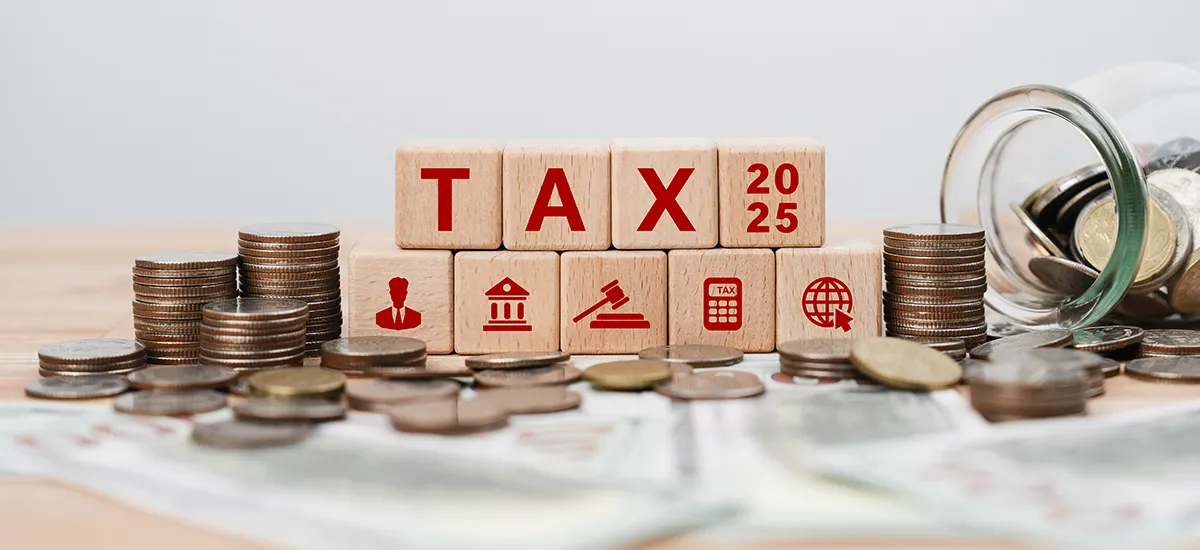Union Budget 2025 Highlights & Income Tax Changes
The Union Budget 2025 India, presented by Finance Minister Nirmala Sitharaman, provides significant reforms aimed at influencing various sectors, including income tax, MSMEs, insurance, and more. As we delve further to know the main features of the new budget, the main focus is on the structure and its effect on taxpayers and the middle-class section. So, let's dig deeper to know the proposed changes and their implications.
Changes in Income Tax Slabs Under the New Regime
The Union Budget 2025 highlights several changes to the income tax slabs under the new tax regime slabs, especially for those earning under ₹12 lakhs. Understanding the income from salary tax slab is essential for disposable income and encourages expenses, which are expected to stimulate the economy. Taxation changes in income tax slab are as follows:
After Budget 2025 - New Tax Regime Slabs:
Income Range
|
Tax Rate
|
₹0 to ₹4 Lakh
|
Nil
|
₹4 Lakh to ₹8 Lakh
|
5%
|
₹8 Lakh to ₹12 Lakh
|
10%
|
₹12 Lakh to ₹16 Lakh
|
15%
|
₹16 Lakh to ₹20 Lakh
|
20%
|
₹20 Lakh to ₹24 Lakh
|
25%
|
Above ₹24 Lakh
|
30%
|
Additionally, the tax rebate under Section 87A has been increased to ₹60,000, ensuring that individuals with net taxable incomes up to ₹12,00,000 have zero tax liability.
Example Calculation:
Let's calculate the income tax for an individual with a gross annual income of ₹18,00,000 under the new tax regime for FY 2025-26.
Income Breakdown:
○ First ₹4,00,000: No tax (Nil rate)
○ Next ₹4,00,000 (₹4,00,001 to ₹8,00,000): 5% of ₹4,00,000 = ₹20,000
○ Next ₹4,00,000 (₹8,00,001 to ₹12,00,000): 10% of ₹4,00,000 = ₹40,000
○ Next ₹4,00,000 (₹12,00,001 to ₹16,00,000): 15% of ₹4,00,000 = ₹60,000
○ Remaining ₹2,00,000 (₹16,00,001 to ₹18,00,000): 20% of ₹2,00,000 = ₹40,000
Total Tax Before Rebate:
○ ₹20,000 + ₹40,000 + ₹60,000 + ₹40,000 = ₹1,60,000
Rebate Under Section 87A:
○ Since the net taxable income exceeds ₹12,00,000, the individual is not eligible for the ₹60,000 rebate.
Total Tax Payable:
○ ₹1,60,000
Therefore, an individual with a gross annual income of ₹18,00,000 would have a total tax liability of ₹1,60,000 under the new tax regime for FY 2025-26.
Note: This calculation assumes no additional deductions or exemptions. It's advisable to consult with a tax professional or use an official income tax calculator for precise calculations tailored to individual circumstances.
Old Tax Regime for FY 2025-26 (AY 2026-27)
Income range
|
Tax rate
|
Up to ₹2.5 lakh
|
Nil
|
₹2.5 lakh to ₹5 lakh
|
5%
|
₹5 lakh to ₹10 lakh
|
20%
|
Above ₹10 lakh
|
30%
|
Rationalisation of TDS and TCS
The new Union Budget 2025 regimen also focuses on the rationalisation of Tax Deducted at Source (TDS) and Tax Collected at Source (TCS) regulations. In an attempt to simplify the taxation system, the government proposes a reduction in the complexity of TDS on different payments.
Taxpayers will benefit from a more streamlined process, especially salaried individuals, as well as persons who earn income from various sources. In addition, the threshold for TDS on rental income has been revised to ensure easier return filing. This change will help to reduce the total tax pressure and make the tax collection process more efficient.
100% FDI in the Insurance Sector
The Union Budget 2025 highlights an improvement in the insurance sector, which allows 100% foreign direct investments (FDI) in insurance companies. The move is expected to bring very important capital to this sector to drive innovation, improve the quality of service and increase competition.
Foreign investments are expected to strengthen the insurance industry by increasing consumer confidence and trust. This helps increase the extent of insurance products in rural areas. The goal of the 100% FDI limit is to create more opportunities for companies and consumers to promote economic growth and development.
UDAN Scheme
The UDAN (Ude Desh ka Aam Nagrik) Scheme aims to make air travel cheaper and more accessible to ordinary people. This continues to receive sufficient support during the Union budget 2025. The government plans to increase the number of air travel routes under the UDAN scheme for better connectivity to remote areas and to enhance growth in the aviation sector.
The budget proposes an additional allocation of ₹1,000 crore for this initiative, which aims to increase regional connection and provide access to flights to the business areas. It will also open new economic opportunities in small cities and towns as well.
MSME Investment and Turnover Limits Hiked
The government has announced an increase in the investment and turnover limit for Micro, Small and Medium-sized Enterprises (MSMEs). This step is expected to benefit a large number of businesses throughout India by gaining more benefits under several schemes.
New limits are also proposed for the expansion of MSME which makes funding easier and helps participation in the government's procurement processes. The budget also introduces measures to increase the credit availability of MSMEs and encourage them to invest in innovation and technology.
Union Budget 2025 Summary
The Union Budget 2025 summary provides a strong benchmark for growth and development in the country in 2025. The changes in income tax slabs, rationalisation of TDS/TCS, and the emphasis on insurance, and MSMEs reflect the government's commitment and dedication to fostering economic development and social welfare.
For taxpayers, the proposed changes to the income tax slabs under the new regime will lead to significant savings, especially for people with income less than 12 lakhs. As individuals want to maximise their savings, it is a great time to consider insurance products. Generali Central Insurance offers solutions that protect your future and provide tax benefits under Section 80C.

























